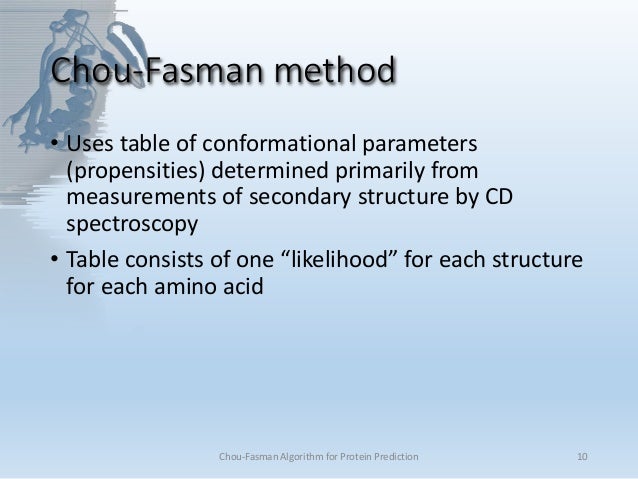Chou Fasman Prediction Program
5 1994 Pages 495-500An Excel spreadsheet computer program combining algorithms for prediction of protein structural characteristics Josep Clotet1, Juan Cedano2 and Enrique Querol112-3A program running on personal computers (either Apple Macintosh or PC, using Excel worksheets) for the prediction of some protein structural characteristics is reported. The program runs according to the Chou and Fasman algorithm, with some modifications, for secondary structure prediction.
The program also incorporates several complementary analyses for secondary structure prediction to help the user in the decision-making process: rules for amino acid preferences in the N-cap and C-cap ofa-helices; prediction of the protein structural class and search of sequential motifs related to secondary structure. Additional algorithms performed by the program are: prediction of domain boundaries, prediction of loops, prediction of the state of cysteines (reduced or in disulfide bridge), hydropathy profiles according to Kyte and Doolittle, Hoop and Woods, and flexibility plot according to Karplus and Schulz. IntroductionThe increasing number of DNA-protein sequences entering databases makes the use of algorithms to predict protein conformation necessary. To generate, from first principles, structures for proteins that are too uncooperative to crystallize or too large for NMR still requires methods of analysis and prediction at the sequence level.
Chou Fasman Method Slideshare
Although the number of computer approaches such as modeling, neural networks, empirical predictive algorithms (such as those of Chou and Fasman, 1978; Garnier et al., 1978), etc., are still considered by researchers, and are even offered in sophisticated program packages such as those from GCG (Genetics Computer Group, University of Wisconsin, Madison, WI), some of these algorithms are easily performed on personal computers (Fasman, 1989). New approaches for secondary structureprediction (for a review see Thornton, 1991; Russell and Barton, 1993) make use of the similarity among members of protein families to distinguish loop regions from regular secondary structures (Zvelebil et al., 1987; Rost and Sander, 1993). The power of the method lies more in considering the parsing of the sequence than in the algorithm used for secondary structure prediction.
G Http Www Biogem Org Tool Chou Fasman

Jpred

New methods based on neural networks are being developed, but they perform at their best when a family of sequences to compare also exists (Rost and Sander, 1993). Pdf excel converter crack torrent. We have previously reported a program to perform the Chou-Fasman algorithm (Parrilla et al., 1986), but it runs on the now outdated Apple II range of computers. The present program, using Excel worksheets, has several refinements with respect to the original procedure of Chou and Fasman (1978). This program makes less overprediction of turns. It also uses Boolean alternatives to take a decision when secondary structures overlap. In addition, some useful algorithms have been incorporated: hydropathic profiles (Hoop and Woods, 1981; Kyte and Doolittle, 1982) and several algorithms to help the analysis of conformation.